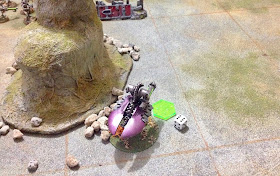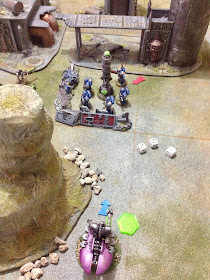The last battle (game 9) was a draw so all army elements remained in the campaign square. The next campaign moves may see both sides getting some much needed reserves from nearby campaign zones. However, after the campaign activations, neither side was able to gain additional support, and we have Baron Bechard again facing two English army elements under the command of Prince Riddick.
As both sides had remained in the campaign zone they were allowed to prepare defences. A combination of stakes and pavises was allocated to both sides determined by an average dice roll.
 |
| French and English forces remain in the same campaign square after a drawn battle |
The terrain was generated by the usual dice rolls and a well placed river with only two crossing points was to the advantage of the defending French.
 |
| The main English force |
 |
| The French in prepared positions |
 |
| Both side position one unit to cover the wooden bridge |
The French were able to field:
- 4 x foot men at arms
- 1 x foot sergeants
- 3 x crossbow
While the English took to the field with:
- 1 x mounted men at arms
- 3 x foot men at arms
- 3 x archers
- 2 x foot sergeants
The games opening moves saw both sides happy to exchange volleys of arrows in an attempt to wear down the opposition. The English were able to concentrate their archers and won the opening phase of the game forcing the French line back from the bridge.
 |
| English archers advance to exchange volleys with their opposite number |
 |
| Missile fire forces the French left flank to give way |
The next phase of the battle saw the English move forward on both bridges. The French had moved the crossbow unit defending the wooden bridge across to support the defence of the stone bridge.
 |
| English foot sergeant unit advances on the undefended wooden bridge |
 |
| The main English attack was advancing to cross the stone bridge |
The English assault moved swiftly across the stone bridge. Some poor activation rolls by the French allowed the English men at arms to cross the bridge relatively unscathed.
 |
| French face attacking English. While in the background Prince Riddick moves his single mounted unit to his left flank. |
 |
| Soon all French reserves were involved in a fierce battle to throw back the attacking English |
The first assault by the English was successfully forced back by the defenders lead by Baron Bechard. Of particular note was the remaining crossbow unit which shot volley after volley of bolts to deplete the attacking English.
 |
| French defenders put up a strong defence |
 |
| The main English assault is thrown back across the stone bridge |
With the defenders wakened after the first assault, the English regrouped and moved their archers into position to support the next assault. Meanwhile the English mounted men at arms had crossed the wooden bridge.
 |
| The English army prepares for a second assault |
 |
| The English are able to coordinate their attacks on both flanks |
The combined attack from both bridges was too much for the gallant defenders who ceded the field of battle. Included in the casualties was the brave Baron Bechard, who was slain in the confusion of the final melee.
 |
| A major English victory |
So Prince Riddick was able to pull off a major victory. An important win for the English who can now determine the path of retreat for the French and open the way to the awaiting ships. The next campaign moves will determine how much of the English army escapes.
The English get 1 campaign point for each army element that makes it to the ships, and 1 additional point for the baggage. The French get 1 point for each one stopped. This could be a dangerous time for the English, moving their baggage to the ships will deny them the ability to field so many archers and foot sergeants. Something the French could easily capitalise on.


























































